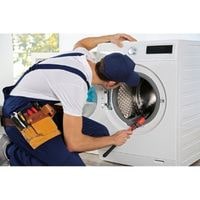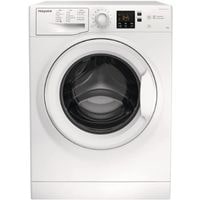Hotpoint washer troubleshooting. Hotpoint is one of the largest washer vendors in the US, thanks to the firm’s reputation for quality and appliance longevity.
However, there are times when problems may arise that could potentially cause damage to your machine. It’s important you deal with these problems as soon as possible to save your washer from any further deterioration.
Fortunately for you, we have compiled a list of common issues that occur in Hotpoint washers and provided some helpful remedies for each situation.
Hotpoint washer troubleshooting

Here we will discuss some common issues and solutions for Hotpoint washer troubleshooting.
Washer Fails to agitate
It may be enough to simply replace the agitator repair kit, which includes the most likely wear-out or failed components of your washer.
You should replace these components if they’re worn or damaged. An agitator is connected to the washer transmission by the drive block. It should be replaced if damaged or worn out.
To replace the drive block, remove the four hex head screws holding the washer lid in place, then pry off the old drive block and replace it with a new one.
Determine whether the drive belt is broken or loose on the pulleys by inspecting it. Replace the drive belt if needed.
The washer Won’t fill
A washer fills up through a water inlet valve. The valve is meant to do just that only: fill it up. If yours isn’t fulfilling its main function to get the appliance filled, clean it out and see what happens.
Maybe you’ve got a blockage going on, or the valve is not designed as expected. We’ll help with any issue you need to be uncovered!
The water pressure could be the culprit. To check if it is indeed the valve that’s causing the problem, you need to see if your home has insufficient water pressure.
Comparing what you get during peak hours with your water meter is the first step.
Washer spinning Failure
If your washer doesn’t spin when the lid is open, it’s possible that the reason is that the lid switch is defective.
To determine if this is true, use a multimeter to test for continuity from the post/terminal on the lid switch. If there is no continuity, you may have only one option to replace.
The door latch closes the washer door shut during normal operation. The washer will begin operating once the door is closed on the washer.
The door switch will prevent the washer from operating if the door is not latched shut. Check the door latch for damage. It should be replaced if damaged.
If not damaged, inspect for continuity at all switches on the latch and replace any defective ones.
Washer leaking water Issue
Water is pumped out of the drain hose by the drain pump. If the seal around the drain pump is damaged, or if the bearings inside are worn out, leaking can occur either in or outside of the area where it’s housed.
This is not an easy fix, so in order to make sure you have a consistently working pump down there without fail, you should replace it with a new one before working further.
If the tub seal is torn, water can seep through it and leak into the bearings. This can cause them to fail in the event of a tear in one of them.
We recommend replacing the tub seal as well as the bearings. We’ve included a link above so you can check out our guide on how to remove and replace these parts.
Stop At Mid Operation
The washer door lock avoids the washer from starting when open. Once the washer has been started, it can proceed with its normal functions until it is turned off.
If the switch is broken and does not allow the machine to only work when all doors are closed, then, for example, during a spin cycle.
Different appliances could become damaged because of this extra movement without being protected on top of also allowing unsupervised operation of children or pets inside the still spinning machine not being between your legs.
In the rinse cycle, water enters the washtub through the water inlet valve. If it opens too much, you can end up with mold. If the water inlet valve does not open at all, then you won’t be able to do any laundry at all.
Map out a course of action: first, check continuity on the valve with a multimeter and then replace it if it’s damaged.
Overflowing Issue
It indicates a defective water inlet valve if the washer is filling with water but unable to dispense cold water. This happens as a result of it being blocked due to sediment buildup or objects floating into it.
As a solution, one has to shut off power to the machine, let it run, and drain itself completely,
unplug all hoses underneath, then remove the bottom panel so that any standing water can be released before removing and replacing the faulty part that caused the problem!
The pressure switch will turn off the water inlet valve when the correct level of water is reached.
If the pressure switch fails, the water inlet valve will remain open, causing excess water to fill up inside of your washer tub, which can overflow and damage both your cabinet and machine.
Related Guides
